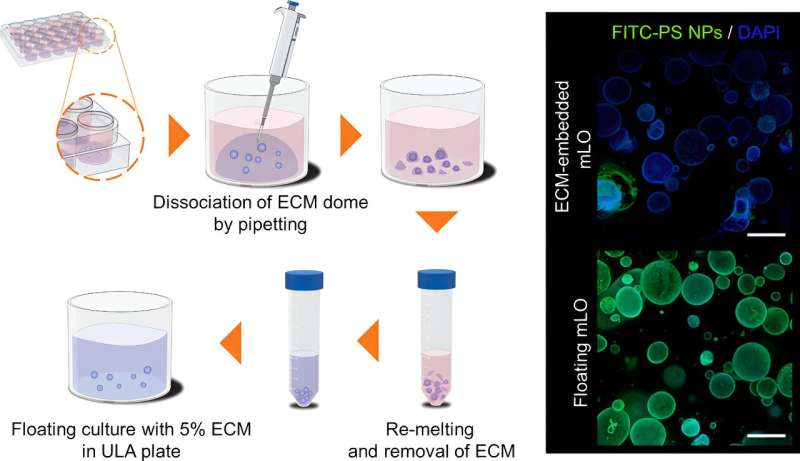This article has been reviewed according to Science X's editorial process and policies. Editors have highlighted the following attributes while ensuring the content's credibility:
fact-checked
peer-reviewed publication
trusted source
proofread
New organoid culture method can verify human toxicity of nanomaterials

The Korea Research Institute of Standards and Science (KRISS) has developed the world's first organoid culture method capable of accurately assessing human toxicity of nanomaterials. Overcoming the limitations of the conventional culture method, this new technology is expected to bring forward the commercialization of organoid-based safety assessment of nanomaterials and nanomedicine.
The paper is published in the journal Nano Letters.
An organoid is a miniaturized version of an organ produced by culturing human stem cells in vitro. Since an organoid effectively simulates the human body, organoids are attracting much attention as a means of next-generation toxicity assessment, replacing animal tests; however, they have a drawback: the standardization is difficult due to limitations in the culture method.
In the conventional organoid culture method, cells are embedded in the extracellular matrix and solidified in the shape of a dome to form a three-dimensional structure; then a culture medium is added to culture the cells. In this method, the thickness of the extracellular matrix dome varies at the center and the edge, causing an oxygen supply imbalance.
As a result, the organoids fail to grow uniformly; instead, they aggregate in the dome like bubbles and thus are difficult to divide. The biggest problem is that nanomaterials cannot penetrate into the dome, so their impact on the organoids cannot be accurately confirmed.
In the newly-developed organoid culture method, the extracellular matrix is directly mixed with the culture solution to culture organoids in a floating manner.
This method is suitable for commercialization because organoids can be produced in a relatively uniform size and can be easily divided into identical numbers. Uniform preparation and division are essential because high-throughput screening is performed in actual industrial sites by placing a maximum of 1,000 organoids into each container to simultaneously test their reactions to nanomaterials.
Another great benefit of the new method is that, unlike the conventional culture method, the absence of the extracellular matrix dome allows each nanomaterial to reach the organoids. The nanomaterial penetration rate is the same as that in the two-dimensional cell model currently used in industrial sites. The newly developed culture method is the world's first to allow confirmation of nanomaterial penetration into organoids.
The KRISS' Nanobio Measurement Group initially cultured organoids for three days using the conventional method. After removing the extracellular matrix dome, they carried out floating culture of the organoids in a culture solution mixed with the extracellular matrix at a concentration of 5% (v/v) to test the toxicity of nanomaterials.
The organoids were treated with zinc oxide nanoparticles (ZnO NPs), which are a liver toxic material, and nontoxic gold nanoparticles (AuNPs). The comparison showed that the toxicity of each material could be accurately observed, in contrast to the conventional method.
Ahruem Baek, a senior researcher at KRISS, said, "Based on our results, we will establish standard nanomaterial and nanomedicine safety assessment procedures using organoids, contributing to the advancement of Korea's nano-industry."
The results from this study may allow for rapid and accurate safety assessment of nanomaterials and nanomedicine using organoids, contributing to the safe utilization of nanomaterials in various strategic technical fields.
Tae Geol Lee, the head of the Nanosafety Metrology Center at KRISS, said, "As the need for animal replacement testing, required by the Ministry of Food and Drug Safety and the US FDA, is continuously growing, it is very meaningful that we have developed the world's first organoid-based nanomaterial safety assessment technology through convergent and cooperative research with a hospital."
More information: Ahruem Baek et al, Novel Organoid Culture System for Improved Safety Assessment of Nanomaterials, Nano Letters (2024). DOI: 10.1021/acs.nanolett.3c02939
Journal information: Nano Letters




















